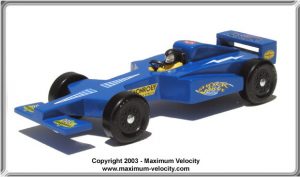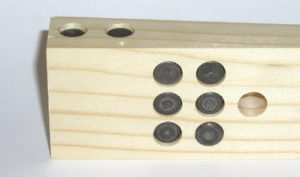If you want to build the fastest pinewood derby car at your next competition, there are five key components to increase your car’s performance come race time. At Maximum Velocity, we have over twenty years of experience in pinewood derby competitions, and have found that the following mechanisms play an important role in designing a winning car.
Building The Fastest Pinewood Derby Car

The major inhibitor to speed during this process is friction, which comes from two main places. Wherever two parts of a car touch, friction is formed. This can include the wheels, axles, car body, etc. Secondly, the air flow that runs atop the car also provides some resistance, and acts to slow the car as well. To build the fastest pinewood derby car at competition, you need to maximize your momentum while also minimizing friction.
Quality Lubrication
A major way to decrease friction is by properly lubricating your wheels and axles. Graphite is a popular form of lubricant and features a low carbon content. There are plenty of graphite varieties available, but you want to make sure you purchase a quality product. At Maximum Velocity, we offer a high-purity small flake graphite lubricant, Max-V-Lube. It has been proven to produce top results in pinewood derby competitions.
When applying the graphite, take time to work it thoroughly. Spend five or so minutes per wheel adding graphite, spinning the wheel, adding more, etc. Because graphite works best after a break-in period, don’t attempt to apply a casual puff before race time, or re-lubricate between heats. Although some racers use common household items- like WD40 or food oils – to lubricate their cars, high quality graphite consistently performs better.
Properly Prepared Wheels and Axles
Nearly all friction gained during a race comes from the wheels and axles. Use a Mini-File to remove flashing under the nail head or minimize ridges on the shaft. You want to ensure that the nails are straight and round. Polishing the axles can also help with reducing friction as well.
Depending on the wheels you have, preparation steps can change. Remove flaws on the tread surface or inside edge using the Pro-Wheel Mandrel or fine grit sandpaper. Polishing and waxing the wheel bore can also reduce friction and increase performance.
Perfect Alignment
To get to the finish line as quickly as possible, the car needs to go straight. Zigzagging down the track and bumping into rail guards adds distance and time to your race. To minimize alignment needs, make sure that axle slots or holes are perfectly parallel to each other, and that the axles are straight.
Maximized Momentum
To increase your car’s momentum, you need to make sure your pinewood derby car is properly weighted. This process is twofold; you want to choose the correct weight with the right density to ensure your car reaches the maximum limit allowed, and you also want to make sure you position those weights at the proper place on the car.
Add weight towards the rear of the car, centered around the rear axles. This pushes the car along the flat section of the track, instead of trying to pull the car forward. Weight type is also important, because it plays a determining factor in where you can position your weights.
High density weights, like tungsten or lead, require less volume of space, allowing you more freedom in designing your car. Steel weights may be more cost effective, but their size may limit where they’re placed on the car body.
Aerodynamic
While this may play the smallest part in designing the fastest pinewood derby car in a race, it should not be considered trivial. There are a few ways to improve your car’s aerodynamics, including the addition of fenders and choosing a lower profile for your car body shape. Wings, sails and flags should also be removed, as they can cause drag and slow your car. A smooth, slick paint job also helps increase your car’s ability to cut through the air flow and improve your performance.
Speed to the Finish
For more tips and tricks on creating the fastest pinewood derby car at your next competition, check out our comprehensive booklet, Speed to the Finish. In it, we reveal tried-and-true techniques to improve your car’s ability to overcome the competition.
When it comes to optimizing your car for the competition, let us help you reach maximum velocity!

